#Maya ruins of Palenque
Text

1000-Year-Old Maya Tomb Unearthed in Mexico
Mexican archaeologists unearthed a richly adorned human body in a grave that could be more than 1,000 years old, in an area where workers were finishing construction on a major tourist rail project, the country's national antiquities institute INAH said on Monday.
The discovery took place this month during archaeological salvage work carried out in tandem with building a multibillion-dollar tourist train in southern Mexico designed in large part to draw tourists to southern Mexico's many ancient Maya sites, as well as nearby top beach resorts like Cancun and Tulum.
The rail project, known as the Maya Train, is a top economic development priority of President Andres Manuel Lopez Obrador. It employs teams of relatively well-funded archaeologists who have rushed to complete excavations so the construction work will not be delayed. Digs elsewhere in the country have suffered budget cuts.
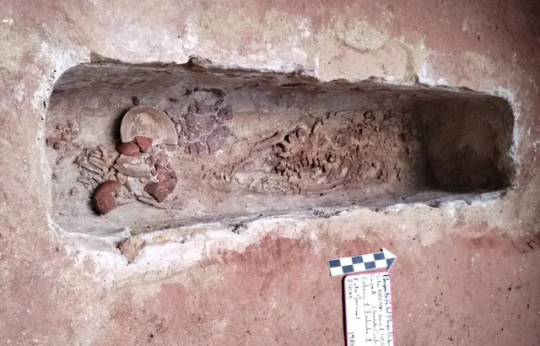
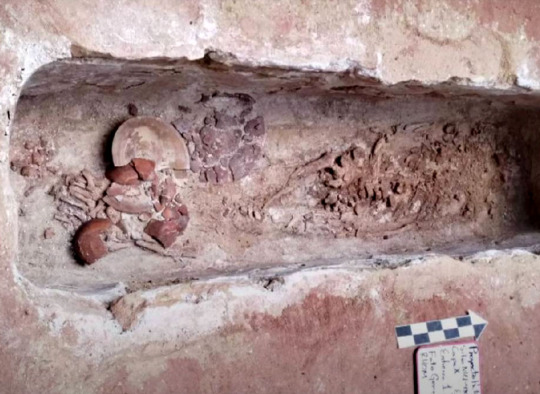
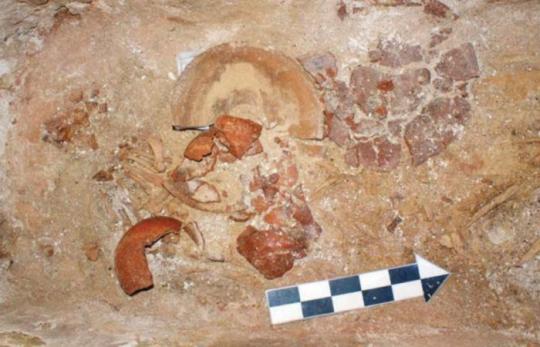
The latest burial discovery took place during work on the construction of a hotel near the major Maya ruins of Palenque in Chiapas state, once home to one of the ancient civilization's largest and most sophisticated urban centers.
The skeletal remains were found some 2 kilometers (1.2 miles) from the city's center, home to towering temples and a sprawling palace compound, in a stone box. They likely pertain to an elite resident of the city, known by the ancient Maya as Lakamha'.
The box also held three ceramic vessels, ear flares and a pair of greenstone beads.
INAH also noted that the individual was buried face up, his head facing north, adding that further testes are needed to determine the individual's exact age and other characteristics.
Scholars credit the ancient Maya with major human achievements in art, architecture, astronomy and writing.
Palenque, like dozens of other ancient cities clustered around southern Mexico and parts of Central America, thrived from around 300-900 AD.
Reporting by Carolina Pulice; Editing by David Alire Garcia and David Gregorio.

#1000-Year-Old Maya Tomb Unearthed in Mexico#Maya ruins of Palenque#ancient grave#ancient tomb#ancient artifacts#archeology#archeolgst#history#history news#ancient history#ancient culture#ancient civilizations#maya history
36 notes
·
View notes
Text

#palenque#temple#mexico#archaeological#ruins#maya#mesoamerica#mayans#history#archaelogy#architecture#jungle#mayan#archaeology
128 notes
·
View notes
Text
The civilization that built these structures is long gone, but Huchim is one of 7 million people of Maya descent living in places like Mexico, Guatemala, Honduras, Belize, El Salvador, Nicaragua and Costa Rica.
“The Maya do not die, they do not end. We are alive. What’s more, we have a large population,” says Huchim, “I am Mayan, but we don’t build pyramids today.”
1 note
·
View note
Photo
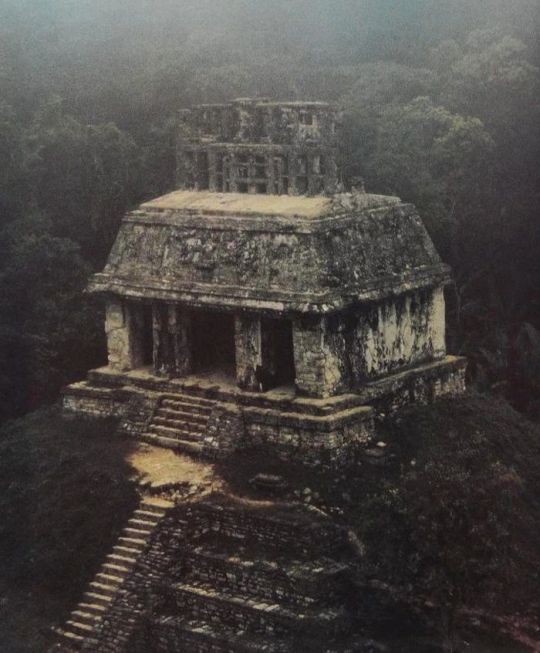
Maya ruins, ceremonial center known as Palenque, 1984. From "Mysteries of the ancient Americas: the New World before Columbus". https://www.instagram.com/p/Ce6n9opNNyo/?igshid=NGJjMDIxMWI=
1K notes
·
View notes
Text
ssh - in the garden! in the garden!
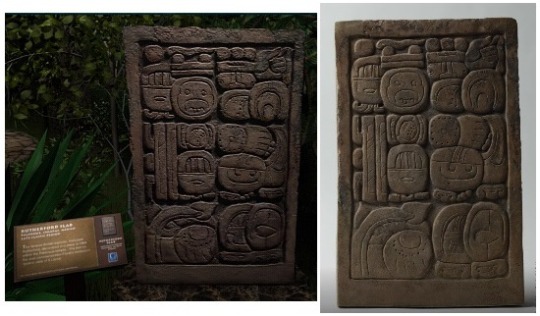
Lápida de Dupaix - Palenque, 7th century CE; excavated in 1807; on display at the Museo Nacional de Antropologia, Mexico.
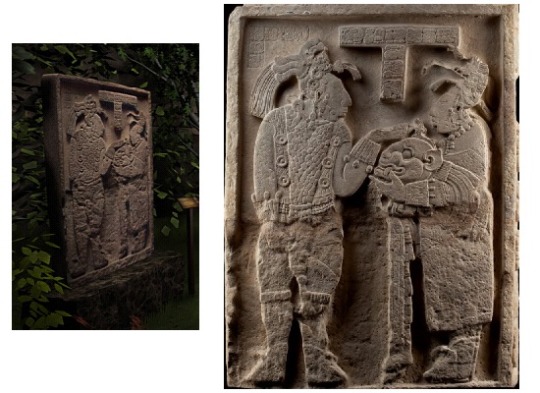
Yaxchilán Lintel 26 - Yaxchilán, 723 CE; excavated in 1897; on display at the Museo Nacional de Antropologia, Mexico.
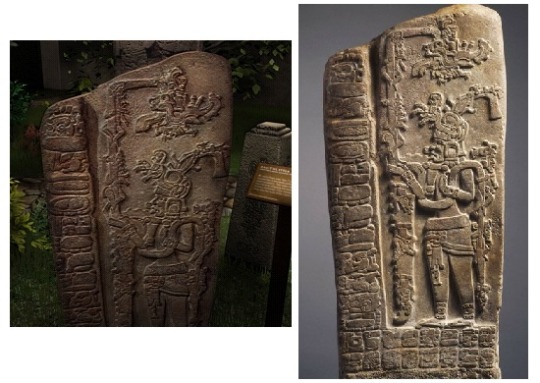
Hauberg Stela - [???], 300-500 CE; first exhibited in 1970; on display at the Princeton University Art Museum, New Jersey (donated by John H Hauberg).
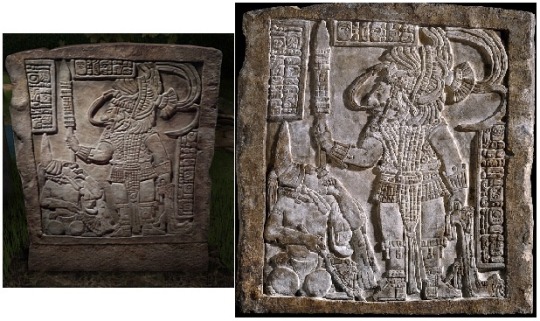
Yaxchilán Lintel 16 - Yaxchilán, 755-770 CE; excavated in 1880s; on display at the British Museum, UK.

Yaxchilán Lintel 25 - Yaxchilán, 725-760 CE; excavated in 1880s; on display in the British Museum, UK. (HERE is a really neat breakdown of the building 23 lintels, along with incredibly detailed pics!)
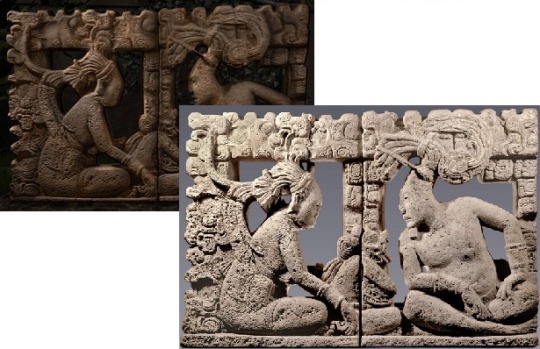
Backrest of a throne with a ruler, a courtier (probably a woman) and a deity in the center - Usumacinta River Valley (possibly Piedras Negras), Late Classic Period (600-909 CE); on display at the Museo Amparo, Mexico.

Calakmul Stela 51 - Calakmul, 731 CE; excavated in 1931; stolen in the 1960s when it was cut into pieces to ease transportation (if you zoom in at the link you can see the lines where the pieces have been reassembled); on display at the Museo Nacional de Antropologia, Mexico. (further info HERE)

Copán Alter G1 - Copán, 766 CE; excavated in the 1800s; replica (pictured above) on display outdoors in the Grand Plaza at the Copán ruins site, while the original can be seen inside the on-site Museo de Esculturas. Copán, Honduras. (the British Museum has some neat photos of the site at Copán and Alter G1 as it appeared in 1890/91, click ‘Related Objects’ to view them)

Presentation of Captives to a Maya Ruler - Usumacinta River Valley (possibly Yaxchilán), 785 CE; purchased on the art market in 1970; on display at the Kimbell Art Museum, Texas. (check out the paint that’s still visible on this one! that’s so cool!)

Yaxchilán Lintel 15 - Yaxchilán, 770 CE; excavated in 1880s; on display at the British Museum, UK. (note the similarities between this design and that of lintel 25 above!)
#colour me shocked but most of the general info re date and place of origin provided in game was correct! holy wow batman!#even more surprising - they're all about the size they ought to be?#that is legitimately so much better than i was expecting#not technically relevant but i did find a site with the specs to 3D print replicas of most of these#honestly i put this together ages ago when i desperately needed to look at something other than impressionist landscapes#and now it's ssh week so hey#here it is#nancy drew#clue crew#secret of the scarlet hand#ssh#nd art id
91 notes
·
View notes
Text

Maya nose ornament made of human bone unearthed at Palenque Ruins
Archaeologists have discovered an intricately carved nose ornament crafted from human bone, during their excavations at the Maya city of Palenque in Mexico.
The archaeological site of Palenque, also known as Lakamha in the Itza language, is situated near the Usumacinta River in the Mexican state of Chiapas. The recent excavation took place at House C, a part of a palace complex constructed by the revered Mayan ruler Pakal the Great.
The nose ornament, measuring just over 6 centimeters long and 5 centimeters wide, is believed to be over 1,100 years old. It is made from a fragment of the human distal tibia, a bone that contributes to the ankle joint.
Continue Reading: https://archaeologymag.com/2023/09/maya-nose-ornament-unearthed-at-mexico/
.
.
Archaeology News
#archaeology #archeologia #arkeoloji #archaeologynews #ancientworld #ancientknowledge #ancientcivilization #mayanculture #anthropology #pakalthegreat #mayanruins
31 notes
·
View notes
Text
Investigators of the El Tigre ruined Maya city in Campeche, Mexico have just revealed a previously unknown structure with ties to the deity Kukulcán. This lesser-known site is fast becoming a must visit for the Yucatan Peninsula.
28 notes
·
View notes
Text
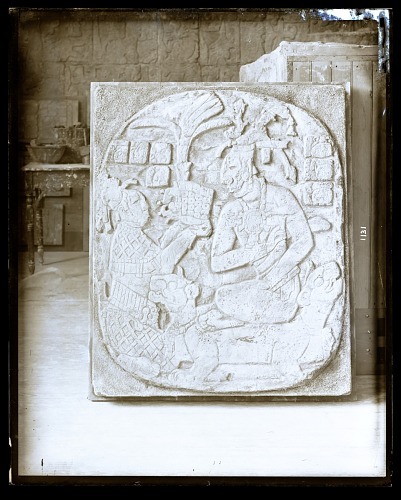
cast of bas-relief slab from temple of the cross at maya ruins of palenque in chiapas, mexico
2 notes
·
View notes
Text
A deep-dive on the design of a Mega Man X boss who dies after two scenes
Does anyone remember Incentas? He dies wrestling a sexy gambler in Mega Man X: Command Mission. Whatever.
Most Mega Man X bosses are anthropomorphic animals or plants or mythical creatures, but wtf is Incentas supposed to be? He's got six hands and three faces, and his body is made of energy. What even.

Well, I recently deduced an answer! (I've already updated the wiki, of course).
First of all: in his boss fight, Incentas has three different elemental forms. They're called Burning Genie, Lightning Genie, and Dancing Genie. So I guess he's a genie, but there's a lot more to him than that.
See, Incentas' three forms each use different parts of his body: one face and one pair of hands. These faces and hands are all given unique names in his concept art, translated by Udon for the Complete Works book.
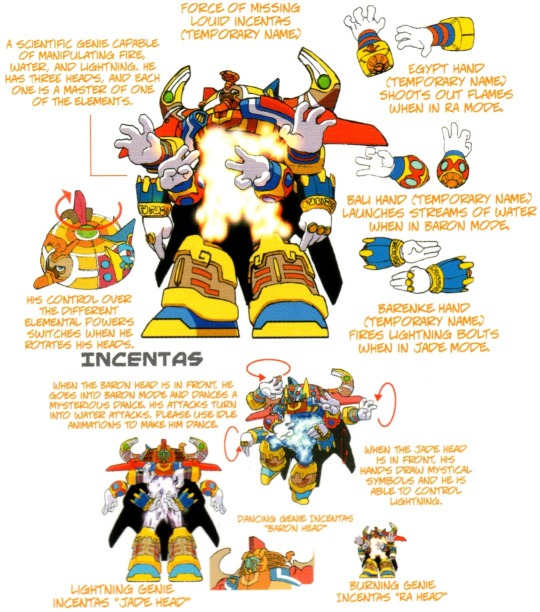
Burning Genie form uses the Ra Head and Egypt Hands.
Lightning Genie form uses the Jade Head and Barenke Hands.
Dancing Genie form uses the Baron Head and Bali Hands.
You may immediately notice that there's a theme in Burning Genie's limbs: Ra is an Egyptian god of the sun, connecting this form to ancient Egypt. He even has big calm eyes, a beard, an an uraeus (the cobra headpiece) like the famous Mask of Tutankhamun.


That's neat. But what about his other two forms?
Lightning Genie has the Jade Head and Barenke Hands... Hm. The reference here is not immediately apparent. Let's look at the original Japanese concept art:

The word Barenke is written (パレンケハンド) in Japanese. You know what else can be written that way? Palenque, an ancient Maya city-state located in modern-day Mexico. This reference was totally lost in translation.
It's compounded by the Jade Head, since one of the most famous ancient Mayan relics is the Death Mask of Pacal the Great, which was discovered in Palenque. Said death mask is made of jade, perfectly aligning the head and hand inspiration. His Jade Head has the same green color and kinda sad-looking eyes. Also, it's a royal funerary mask like the last one.


Now for the last one: the Dancing Genie with its Baron Head and Bali Hands. We get a big hint with the word Bali, a province of modern-day Indonesia. That's a third ancient kingdom for Incentas. But what is the Baron Head supposed to be?
Again, it was lost in translation. Baron is written (バロン) in the Japanese concept art, which is also the same way that the Balinese Barong is spelled. The Barong is a panther-like character, a king of good spirits which is included in the traditional Barong dance with a huge mask. Hence this form's Dancing Genie title, and the round vacant eyes and tusks of its Baron Head.


These three inspirations - Egypt, Maya, and Bali - show that Incentas is really based on royal masks from ancient civilizations. All three were once powerful kingdoms with long-lasting relics, architecture, and customs. He really doesn't have much to do with genies at all, as djinn are from pre-Islamic Arabian cultures.
For this reason, I find that the alternative translation of Incentas - "Ancientus" - is a much more fitting name. That's what he was called in the game's E3 demo, so why was his name was changed? Possibly because it's a bit difficult to pronounce in English.
Speaking of his name, in the Japanese concept art he's called "Rouid Ancientus" (ルイード・エンシェンタス). This is likely a draft name, since his fellow bosses have some leftover draft names in their concept art too. But still, what could that first word mean? Could it be a corruption of the English word ruined, reflecting his ancient inspirations? I'm still so curious.
Anyway, Incentas Ancientus has an underrated design, and I hope his designer knows that we acknowledge and appreciate all their hard work and research.
#mega man x#mega man x command mission#incentas#ancientus#spider#x#zero#gimialla mine#concept art#translation#mega man
5 notes
·
View notes
Text
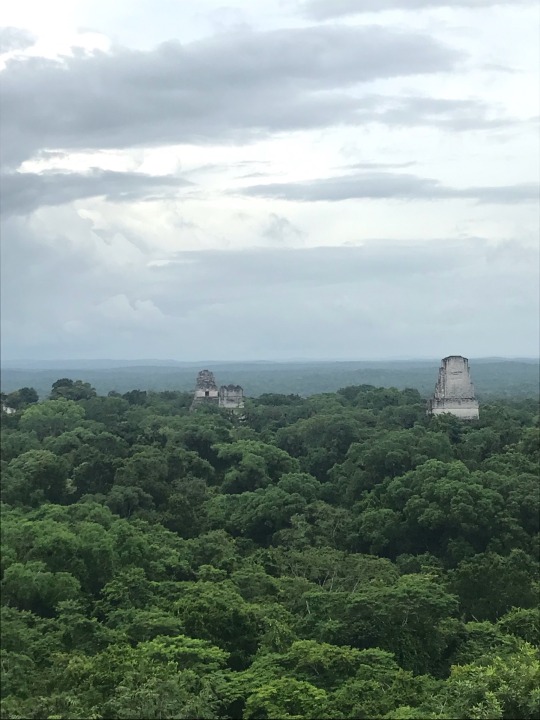


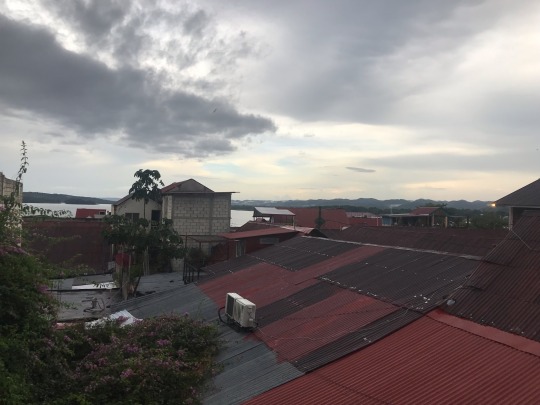
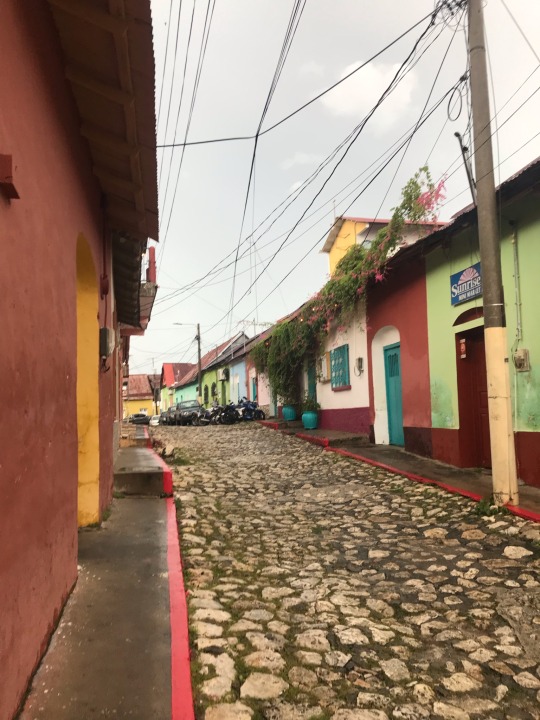
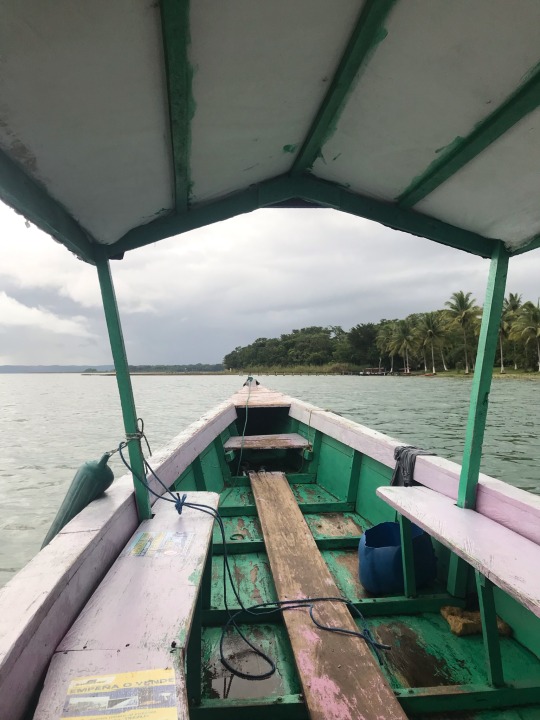

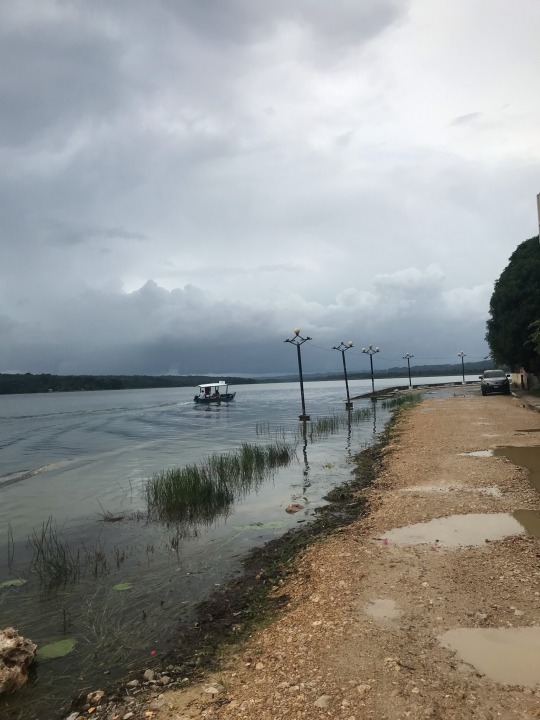

Guatemala Day 14-17
Flores / Tikal
The past few days were spent in the town of Flores in northeastern Guatemala, in the state of Petén. The climate is very different from Antigua and Atitlan, as we are no longer in the mountains. It is very hot and humid here. Flores is on an island in the middle of a lake and it takes about 20 minutes to walk around the entire island.
I stayed in a backpacker hostel and while it was a very nice backpacker hostel I think I’m at a point where I’ve had enough of them. The constant drunk people, dirty laundry everywhere, and no personal space plus the extreme heat got to me. The drunk girl peeing all over her bunkbed in the dorm I was in was the final straw and I switched to a private room for my last night.
While I am technically backpacking myself I’ve gotten really sick of being around backpackers the last few days. They’re not all bad, but so many of them are really entitled and disrespectful to locals. They spend a lot of time loudly speaking English or German or Dutch and leaving garbage everywhere in various states of undress and their main concern being where the next party is and where the alcohol is. A lot of restaurants cater their menu to these crowds and to be honest I found myself hearing more Dutch than Spanish the last few days and going to two different restaurants to find only American and Dutch food on the menu. It seems like another form of colonialism where white people come in expecting locals to cater to them and their culture. I know I’m part of that just being a white American traveling and I try really hard to be respectful and not expect people to cater to me but it’s a much larger, more complex issue than that.
Sorry for the cranky old rant but I was so honestly embarrassed to be around fellow tourists the past few days. The multiple people putting their bare feet by my head while taking transportation and witnessing people wandering into restaurants shirtless, barefoot, and yelling in English made me so grumpy. Like do you behave like that in your home country?
Anyway the reason most people come to Flores is to visit the Mayan ruins of Tikal. Tikal was built by the Itzá Maya (the same who built Chichén Itzá) and was at one point the capital of the Mayan civilization. They were also related to the group that built Palenque in Mexico. It consists of 5 main pyramids which were all used to bury royalty. There were countless other structures as well which have yet to be excavated as well as multiple manmade lakebeds which have since dried up.
We climbed 2 of the 5 pyramids and watched the sunset from the top of another structure. Tikal is in the middle of very dense rainforest. We saw lots of coatis, spider monkeys, wild turkeys, and toucans and heard lots of roaring howler monkeys. I swear they sound just like jaguars.
We were lucky with the weather because it had rained earlier in the day and cooled things off significantly and while we kept hearing thunder it didn’t actually rain while we were there. Tropical thunderstorms can be very intense.
It was dark when we climbed down from the last structure and our guide was able to get the site police to come pick us up in his pickup truck and we rode in the back out of the jungle instead of walking 40 minutes in the dark.
My last day in Flores I didn’t do much due to how sick of being around people I was. I did spontaneously go on a boat ride around the lake which was pretty but also weird because I was the only one there and then it started downpouring.
Currently I am in the town of Lívingston on the Belizean border. It took over 12 hours to get here because of how isolated of a community it is. First I took a four hour bus to the head of Rio Dulce, a large river that reminds me a lot of the Amazon. Then I waited 4.5 hours for a boat since Lívingston is surrounded by dense jungle and is only accessible by boat. Then I road in a boat for 2 hours and finally arrived just before the thunderstorm hit.
On the boat I met an older Mayan man named Gabriel and we talked for a while. He asked how he could visit the US and I didn’t even know where to begin with how complicated that would be. Rich white countries are allowed to visit wherever they want at any time and have the economic privilege to do so due to imperialism but it is next to impossible for folks from countries that have been taken advantage of to do the same. Gabriel and I talked for a while, he sells handcrafts and gives tours of the area. He also shared his coconut bread with me. He offered to take me on a tour tomorrow and while he seemed really nice my stranger danger radar was going off at the thought of going on a boat by myself as a solo traveler with someone I met in passing.
I always doubt myself with decisions like that. I want to be spontaneous and not be distrustful of others or hiding in my room all the time but I also feel very hyperaware all the time of how I’m a young woman travelling by herself in a place I don’t know and I never know when I’m just being paranoid or being smart. It’s exhausting.
Anyway right now I’m staring into a bowl of pasta I don’t if I’ll be able to eat because of a stomachache and watching the lightning storm on the river. I’ll be sleeping in a hut the next few days but it’s a pretty nice hut.
Overall I think I’m getting close to wanting to go home. I’m noticing myself getting easily exhausted and frustrated and not looking forward to things, which usually tends to happen at the end of a long trip. I’m hoping I can enjoy the next few days here regardless because I really am grateful for the opportunity to be here and to travel.
7 notes
·
View notes
Text
I don’t know how much people care about my personal life on here. I am back from two weeks in Mexico. Got to do Día de los Muertos in Mexico, so that was cool. And I saw a ton of ruins and Mayan stuff.
I know you might think I went because of Talokan and Wakanda Forever coming out. That’s just a coincidence. I have wanted to go for awhile. We actually had a small Maya unit in my public US middle school. We had done “Voyage of the Mimi” (which is a weird 90s educational program starring young Ben Affleck, who my class mocked mercilessly). The first one is about whales and the second one is about the Maya, if I recall correctly. Mostly what I knew was they had cool pyramids and knew astronomical stuff.
I also read a book about Hernan Cortes and the conquest of the Aztecs that made me profoundly sad.
So yeah, I was interested but didn’t know much about the history itself. In fact, I discovered I was mixing up Tenochitlan (the Aztec Capitol, now Mexico City’s Centro, especially the Cathedral which is where the original pyramid was) and Teotihuacán (vast ruins outside of Mexico City proper) which made me feel dumb.
Teotihuacán is so BIG. I can’t express it really. We were there for half a day with a guide and we didn’t get to see half of it. These ruins are interesting because they are not quite sure which civilization built here originally. People kept living there well into the time of the Aztecs—when the Spanish arrived—so it’s kind of a place where cultures mix. So much stuff! Biiig.
We climbed the pyramid at Cholula. This is another one the Spanish gutted. They put a church, which is still there, at the top. There is some excavation going on around it. But mostly it’s a very high church and I did not enjoy how much I had to walk up. I am not good at inclines.
We also saw Mitla, which was a Zapotec site, but didn’t have a guide so I didn’t learn as much as I would’ve liked. We did meet a nice, elderly Zapotec man who showed us some weaving though. So that was cool.
Then we hauled our butts to Palenque, our first official Mayan site. It is FAR from anything. But we got a guide to take us hiking is the jungle around it first, to show us how much more there was left to uncover. He found a tiny obsidian blade and a shard of pottery while we hiked, and just put them in a little baggie full of other artifacts he had found, like it was NBD. Palenque was the one site that left me with the sense that more was waiting to be found. Unlike Teotihuacán and many of the other sites, the Palenque site was not in use after the fall of its civilization and the local people did NOT know it was there. So they have made cool discoveries of two tombs which were undisturbed. And the masks they wore were so cool. They also let us climb the pyramids (I only went up one because I don’t like climbing, as I said)
Only 2% of what LIDAR shows has been excavated. I really want them to keep digging! Am like ready to lend a hand if anyone knows about archaeology.
Next, we went to Uxmal, which is great if you want to see detailed carvings and artwork of the Maya. It’s quite intricate, and many other sites the stones weren’t in good condition even if they were still there. (Again, most of these structures may have collapsed or had vegetation growing on them, but the locals knew they were there. People had been in and out so there was often human damage.) It gave me more of a sense of what stuff would have looked like.
Then Chichen Itza, one of the Seven Wonders of the modern world. Boy was it crowded. I joked to my sister that it was the only dig site with a Starbucks (joke’s on me though because Tulum had one too). I mean, the Castillo is very beautiful and big. There are also some smaller structures that have some good detailed reliefs, but not as many as Uxmal.
Finallu Tulum, the only Mayan site by the ocean. Very beautiful setting but also very crowded, especially considering this one is so much smaller than the others. The lookout structures (the “lighthouse”) were worth seeing because no where else has that, but everything else is relatively small and without .
One thing that is now confusing me about BP is that in the trailer M’Baku says Namor is called Ku’kulkan but they also call the country Talokan. Ku’kulkan is the Mayan feathered serpent god (Quetzalcoatl in the north). But then the city is Talokan, for Tlaloc (Chaac in the South). So which culture are they pulling from? Mexica or Mayan?
6 notes
·
View notes
Photo
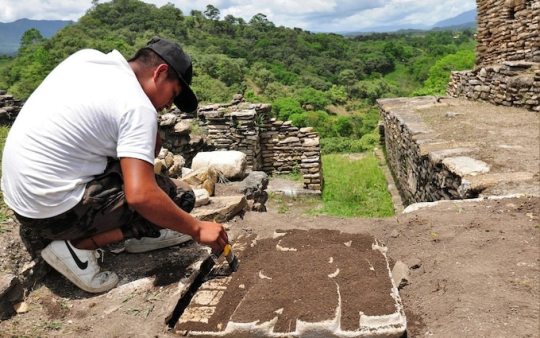

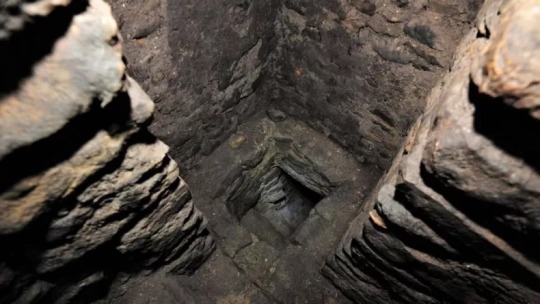



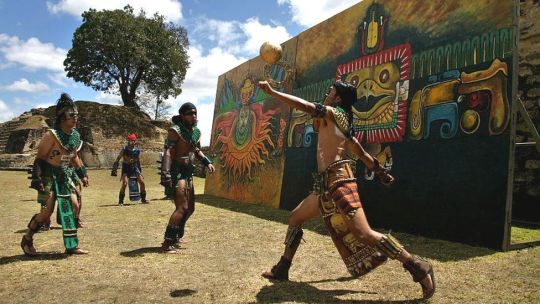
Maya Rulers Ashes Turned Into Pelota Balls
Some Maya rulers may have been incinerated and their ashes mixed with rubber to make the balls used in the game of pelota, an archaeologist says.
Burnt human remains uncovered at the ruins of a Maya city have led to a new theory about the death rites of the ancient civilisation.
Archaeologist Juan Yadeun Angulo came up with the hypothesis after finding urns containing human ashes, rubber and roots at a Maya temple in Mexico.
Pelota is among the oldest team sports.
Mr Yadeun, an archaeologist with Mexico's National Institute of Anthropology and History (INAH), has been studying a recently uncovered crypt underneath the Sun Temple at the Toniná archaeological site in southern Mexico.
Inside the underground crypt and its antechamber, archaeologists found 400 urns containing the mixture of human ashes, coal, rubber and plant roots.
Mr Yadeun believes the crypt was used to burn the bodies of the dead in a religious ritual.
The ashes were then added to other organic material to make the heavy balls used in pelota, the team game played in Mesoamerica thousands of years ago, the theory goes.
The Toniná archaeological site may not be as well-known as that of Mayan ruins in Palenque but it is an impressive complex built on a hill in the jungle of Chiapas.
Among the constructions preserved to this day is the sunken ballcourt where the Maya played pelota.
According to Mr Yadeun, stone carvings at key locations inside the ballcourt offer clues that back up his theory.
He says the stone carvings suggest that three rulers, all of whom died between 722AD and 776AD, were taken to the "cave of the dead" for their "transmutation".
"Just as Egyptians tried to preserve [bodies], we know here they were transformed in another way," Mr Yadeun told Reuters news agency.
The archaeologist thinks that the Maya wanted the bodies of their rules to "be converted into a life force, something to stimulate their people" and therefore worked their ashes into the rubber used to make balls for the game.
"We have evidence they were incorporated into balls, during the Classic Period the balls were gigantic," Mr Yadeun explained.
A carved stone disc found at a different site in Chiapas suggests the size of the pelota ball in the 6th Century and how players propelled it with their hips.
By Vanessa Buschschlüter.
#Maya Rulers Ashes Turned Into Pelota Balls#The Sun Temple#ancient grave#ancient tomb#archeology#archeolgst#ancient artifacts#history#history news#ancient history#ancient culture#ancient civilizations#Maya history#Maya empire
68 notes
·
View notes
Photo

K'inich Janaab' Pakal Ier
K'inich Janaab' Pakal (23 mars 603 - 31 mars 683) était le roi maya de Palenque, dans l'actuel État du Chiapas, au Mexique. Également connu sous le nom de Pacal (qui signifie "bouclier") et Pacal le Grand, il est surtout célèbre pour avoir fait passer la ville de Palenque (connue sous le nom de B'aakal) d'une relative obscurité à une grande puissance, pour ses projets de construction dans la ville (en particulier le temple des inscriptions) et pour le couvercle de son sarcophage minutieusement sculpté, que certains ont interprété comme représentant un astronaute antique à bord d'une fusée. Pacal monta sur le trône de Palenque à l'âge de 12 ans, en 615, et régna avec succès jusqu'à sa mort à l'âge de 80 ans. Il était marié à la dame Tzakbu Ajaw et eut trois fils qui lui succédèrent au pouvoir. Les ruines de Palenque visibles de nos jours ne représentent qu'une petite partie de l'ancienne cité développée et agrandie par Pacal pendant son règne ; le reste de la vaste métropole n'a pas encore été fouillé dans la jungle environnante. Palenque était une ville de taille modeste lorsque Pacal prit le trône, et c'est grâce à ses efforts qu'elle devint l'un des grands centres urbains de Mésoamérique, rivalisant même avec la puissance et la splendeur de Tikal.
Lire la suite...
2 notes
·
View notes
Text
ANCIENT ART :
Sarcophagus of pakal (683 A.D.) the great King of Palenque.

• The large carved stone sarcophagus lid in the Temple of Inscriptions is a unique piece of Classic Maya art. Around the edges of the lid is a band with cosmological signs for sun, moon, and star, as well as the heads of six named noblemen. The central image is that of a cruciform world tree. Beneath Pakal is one of the heads of a celestial two headed serpent. Both the king and the serpent head on which he rests are framed by the open jaws of a funerary serpent, a common iconographic device for signaling entrance into, or residence in, the realm(s) of the dead.
• Pakal, the great King of Palenque who had ruled for almost 70 years, died. Pakal's time had been one of great prosperity for his people, who honored him by entombing his body inside the Temple of the Inscriptions, a pyramid that Pakal himself had ordered built specifically to serve as his tomb. Pakal was buried in jade finery, including a beautiful death mask. Placed over Pakal's tomb was a massive sarcophagus stone, laboriously carved with an image of Pakal himself being reborn as a god.
• The Maya city of palenque had risen to greatness in the seventh century A.D., only to mysteriously go into decline. By 900 A.D. or so, the once-mighty city was largely abandoned and the local vegetation began to reclaim the ruins. In 1949, Mexican archaeologist Alberto Ruz Lhuillier began an investigation at the ruined Maya city, specifically at the Temple of the Inscriptions, one of the more imposing structures in the city. He found a stairway leading deep into the temple and followed it, carefully breaking down walls and removing rocks and debris as he did so. By 1952, he had reached the end of the passageway and found a magnificent tomb, which had been sealed off for more than a thousand years. There are many treasures and important work of art in Pakal's tomb, but perhaps the most striking was the massive carved stone that covered Pakal's body.
MEDIEVAL ART :
Christ of Mercy between the Prophets David and Jeremiah (between c. 1495 and c. 1500) by Diego de la Cruz
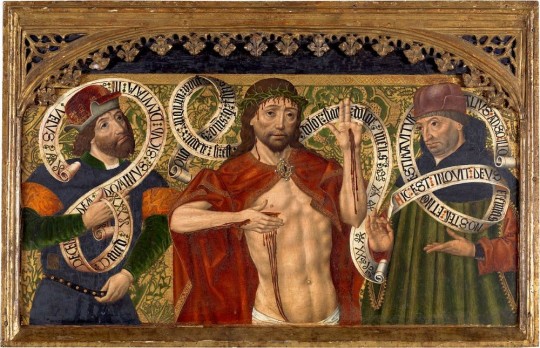
• This devotional, eucharistic image was the central panel in the predella of an altarpiece. Christ is depicted as the Man of Sorrows with the crown of thorns and displaying the wounds of his Crucifixion. The texts on the scrolls refer to his Passion. The artist worked in Burgos, in northern Spain, and collaborated with Gil de Siloé, a sculpture by whom is shown in this room.
• Middle Ages paintings were rich with religious symbolism and imagery. Medieval artists and their paintings predominantly portrayed holy figures and biblical narratives. These narratives had a hierarchy, which was predominantly dictated by the spaces the paintings would occupy. The Medieval artwork that depicted scenes considered to be more important would occupy notable focal points in a church or altarpiece, whereas less significant scenes would radiate outwards.
• Diego de la Cruz was a Spanish painter who may have been of Flemish origin. He was active in Burgos and the neighboring region.His artistic personality is largely defined by two works: Cristo de Varón de Dolores entre la Virgen y San Juan, at the Museo del Prado; his only signed work, probably created between 1475-1480, and the Estigmatización de San Francisco de Asís at the Iglesia de San Esteban de Burgos (1487-1489). Based on an analysis of these works, it has been possible to make other attributions: notably, Cristo de Piedad entre dos ángeles at the Colegiata de Covarrubias , and the Cristo de Piedad entre los profetas David y Jeremías, the central tableau of the predella of an altarpiece and companion to two other tableaux (of the prophets Isaiah and Daniel) in the collection of the University of Liège, which have been attributed to the German painter, Hans Leonhard Schäufelein.
RENAISSANCE ART :
The Last Judgment by Michelangelo Buonarroti (1535–1541)
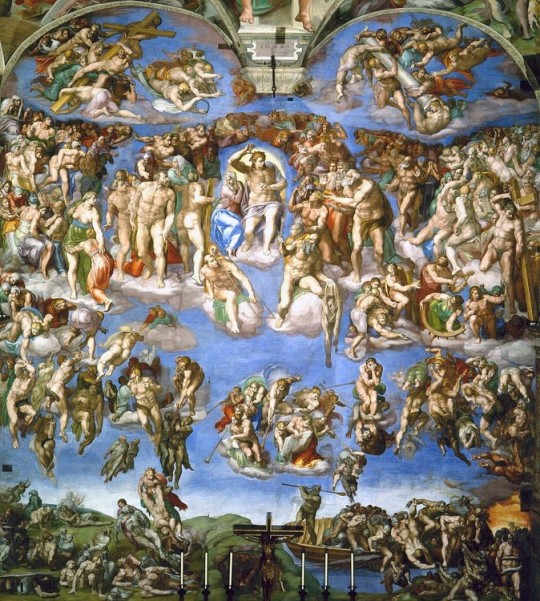
• The painting is about the second coming of Jesus, the day when God shall judge all humanity. Michelangelo has painted Jesus in the center surrounded by saints. The top portion of the painting shows the resurrection of the dead to heaven and the bottom portion shows the descent of sinners into hell. The use of colors and excellent brushwork make this painting of the most revered painting in the world.
• The Last Judgement is the name of the fresco located on the wall behind the altar of the Sistine Chapel in Rome. It was designed and realized by the Renaissance master Michelangelo Buonarroti between 1533 and 1541. Michelangelo’s masterpiece was inspired by Dante’s Divine Comedy and is mentioned by Dan Brown in his Inferno.
• Michelangelo di Lodovico Buonarroti Simoni was an Italian sculptor, painter, architect, and poet of the High Renaissance. Born in the Republic of Florence, his work was inspired by models from classical antiquity and had a lasting influence on Western art. Michelangelo's creative abilities and mastery in a range of artistic arenas define him as an archetypal Renaissance man, along with his rival and elder contemporary, Leonardo da Vinci. Given the sheer volume of surviving correspondence, sketches, and reminiscences, Michelangelo is one of the best-documented artists of the 16th century. He was lauded by contemporary biographers as the most accomplished artist of his era.
MODERN ART :
Radiant Baby by Keith haring (1990)

• Using chalk, he etched his signature designs onto the walls. One of these was his Radiant Baby, which to him was one of the purest and most positive human experiences. It became a recurring visual idiom of Haring’s throughout the years and is now considered the artist’s signature tag. The image represents a pure and positive experience of human existence and is symbolic of Haring’s hope for the future. Although Radiant Baby derives its origin from Christianity it has been used in many of Haring’s other works associated with racism, drug addiction, AIDS awareness and tolerance.
• Keith Allen Haring was an artist and social activist from Pennsylvania whose work was influenced by the New York City street culture and graffiti art of the 1980s. A 1997 Vanity Fair article states that "some of his most characteristic imagery involved figures twirling around and playing together, happy but never aimless." Since Haring's death from AIDS-related illness in 1990, images he created that speak about racism, drug addiction, AIDS awareness and tolerance have become iconic.
CONTEMPORARY ART :
Still face you by Njideka akunyili crosby (2015)

• The artist, wearing a yellow dress, is seen with her husband (in the red shirt) and other family members gathered around a table in an interior. The artist has said that in this painting she was reimagining bringing her husband, a caucasian American whom she met at Swathmore, to Nigeria to meet her family for the first time. The stately rendering of her body in contrappasto evokes both classical sculpture and Old Master painting, The wholly blank expanse in sunshine yellow behind evokes the more contemporary world of abstract painting. The Xerox transfers from Nigerian magazines and from old and more recent family photographs line the walls, articulate the frame of the balcony and animate the patterned dresses worn by the other women present and the checkered upholstered chairs.
• Njideka Akunyili Crosby is a Nigerian-born visual artist working in Los Angeles, California. Through her art Akunyili Crosby "negotiates the cultural terrain between her adopted home in America and her native Nigeria, creating collage and photo transfer-based paintings that expose the challenges of occupying these two worlds". In 2017, Akunyili Crosby was awarded the prestigious Genius Grant from the John D. and Catherine T. MacArthur Foundation.
• When painted in pairs or groups, Akunyili Crosby’s figures rarely meet the viewer’s gaze. Instead, they seem bound up in moments of reflection left open to interpretation by the viewer. Akunyili Crosby’s subjects appear resigned and calm, showing few emotions. Her works render the characters’ mood more than any specific facial features. There is a balance between intimacy and longing, between pleasure and nostalgia.
1:29 pm / Nov,19,2022
2 notes
·
View notes
Text
Ten Days In The Land Of The Maya
Palacio del Gobernador, Uxmal, Yucatan, Mexico
The idea was to stay in a small town, off the beaten track, in central Yucatan. From there, I would explore the many minor, less-visited Mayan ruins in the area. Uxmal is not one of those. Neither is Chichenitza, which I also visited. I visited the two of them, as well as Palenque, in Chiapas, because I had time.
The thing is, I really didn’t have…

View On WordPress
0 notes
Text
Discovering Mexico: A Tapestry of Culture and Adventure
Mexico, a land rich in history, culture, and natural beauty, beckons travelers from around the globe to immerse themselves in its vibrant tapestry of experiences. From the bustling streets of Mexico City to the serene beaches of Cancun, this diverse country offers something for every type of traveler.
The tourism in mexico encompasses a myriad of experiences, from exploring ancient ruins to indulging in delicious cuisine and relaxing on pristine beaches.
One of Mexico's most iconic destinations is the ancient city of Chichen Itza. Nestled in the heart of the Yucatan Peninsula, this archaeological marvel showcases the ingenuity of the Mayan civilization. Visitors can marvel at the towering pyramids, intricate stone carvings, and celestial observatories that whisper tales of a bygone era. As the sun sets, the site comes alive with the mesmerizing spectacle of the Kukulkan Pyramid, where shadows cast by the setting sun create the illusion of a serpent descending the steps.
For those seeking a taste of Mexico's colonial heritage, the charming city of Oaxaca awaits. Its cobblestone streets are lined with colorful buildings adorned with intricate wrought-iron balconies. The aroma of traditional Oaxacan cuisine wafts through the air, tempting visitors to sample delicacies such as mole and tlayudas. Artisans ply their trade in bustling markets, offering an array of handcrafted goods, from intricate textiles to vibrant ceramics. Don't miss the opportunity to visit the nearby Monte Alban, a UNESCO World Heritage Site that offers panoramic views of the surrounding valley.
For beach lovers, the Riviera Maya is a slice of paradise. Stretching along the Caribbean coast, this tropical paradise boasts pristine white-sand beaches lapped by crystal-clear waters. Snorkelers and divers can explore the Mesoamerican Barrier Reef, the second-largest coral reef system in the world, teeming with colorful marine life. Adventure seekers can venture into the jungle to discover hidden cenotes, natural sinkholes filled with refreshing turquoise waters, perfect for swimming and diving.
No exploration of Mexico would be complete without a visit to the vibrant capital, Mexico City. This sprawling metropolis is a melting pot of cultures, where ancient traditions blend seamlessly with modern innovation. Explore the historic center, home to the magnificent Metropolitan Cathedral and the imposing Palacio de Bellas Artes. Art enthusiasts will delight in the works of Frida Kahlo and Diego Rivera at the iconic Casa Azul and the National Palace.
For an immersive cultural experience, head to the state of Chiapas, where indigenous traditions thrive amidst lush rainforests and mist-shrouded mountains. Visit the ancient ruins of Palenque, hidden deep within the jungle, and marvel at the intricate carvings and imposing temples. Witness the vibrant colors and rhythmic beats of traditional Mayan ceremonies, where age-old rituals come to life in a whirlwind of dance and music.
As night falls, Mexico's culinary scene comes alive, offering a tantalizing array of flavors to tempt the taste buds. Indulge in street food delicacies such as tacos al pastor and elotes, washed down with a refreshing agua fresca or a tangy margarita. For a fine dining experience, sample the innovative creations of Mexico's top chefs, who blend traditional ingredients with modern techniques to create culinary masterpieces.
Whether you're exploring ancient ruins, relaxing on sun-kissed beaches, or savoring the flavors of Mexican cuisine, tourism in Mexico is sure to leave a lasting impression. With its rich tapestry of culture, history, and natural beauty, this enchanting country offers endless opportunities for adventure and discovery. So pack your bags and prepare to be captivated by the magic of Mexico.
0 notes